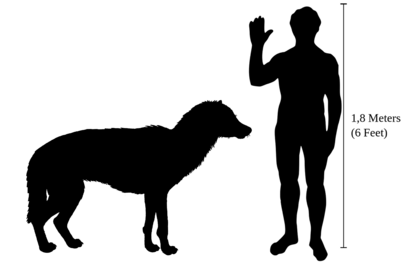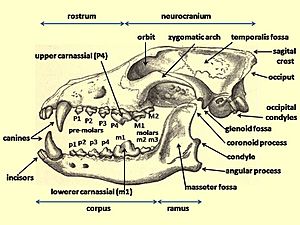Beringian wolf facts for kids
Quick facts for kids Beringian wolf |
|
|---|---|
 |
|
| Two models of Beringian wolves created by paleo-artists working at the Yukon Beringia Interpretive Centre | |
| Scientific classification | |
| Genus: |
Canis
|
| Species: |
lupus
|

The Beringian wolf was a type of wolf that lived during the Ice Age. This means it is now extinct. These wolves lived in areas that are now Alaska, Yukon, and northern Wyoming. Some even survived into a later period called the Holocene.
The Beringian wolf was a special kind of gray wolf (Canis lupus). Scientists have studied it a lot to learn about what prehistoric wolves ate and how they hunted. These wolves looked different from modern North American wolves. Their genes also show they were an older, more basic type of wolf compared to most modern and extinct wolves.
This ancient wolf was about the same size as today's Interior Alaskan wolf (Canis lupus pambasileus). But it was stronger, with powerful jaws and teeth. It had a wider mouth roof (called a palate) and bigger teeth for tearing meat. These special features helped it hunt and eat large Ice Age animals. The Beringian wolf often hunted horses and steppe bison. It also ate caribou, mammoth, and woodland muskox.
When the Ice Age ended, the weather changed. Many of the large animals the Beringian wolf hunted died out. Because its main food source disappeared, the Beringian wolf also became extinct. Scientists think this happened because of climate change, competition with other animals (including humans), or both. Only the ancestors of today's North American gray wolves survived.
Contents
What was the Beringian wolf like?
The Beringian wolf was a strong and powerful hunter. It was built to survive in the harsh Ice Age environment.
How big was the Beringian wolf?
The Beringian wolf was similar in size to the largest modern wolves. Today's northern wolves can be up to 97 cm (38 in) tall at the shoulder. They can be up to 180 cm (71 in) long. A male Yukon wolf usually weighs about 43 kg (95 lb). Females are a bit lighter at 37 kg (82 lb). Some Yukon wolves can weigh up to 79.4 kg (175 lb).
The Beringian wolf was stronger than modern wolves. It had more powerful jaws and teeth. Another ancient wolf, the dire wolf, was about the same size. But the dire wolf was heavier and had an even stronger skull and teeth.
How did its teeth help it hunt?
Scientists studied the teeth of the Beringian wolf. They found it had large teeth for tearing meat. It also had a short, wide mouth roof. This shape helped it bite down with great force. It also made its skull stronger when struggling with large prey.
Today, animals like the spotted hyena have deep jaws similar to the Beringian wolf. Hyenas are known for crushing bones. This suggests the Beringian wolf was very good at hunting and eating large animals. Its strong jaws and teeth mean it ate a lot of meat and even bones.
Scientists also looked at how often Beringian wolves broke their teeth. They found that Beringian wolves had more broken teeth than modern wolves. This suggests they often ate bones. It also means they likely hunted very large prey. Breaking teeth can happen when an animal bites into bones or struggles with big animals.
| Tooth variable | modern North America | Rancho La Brea | Eastern Beringia |
|---|---|---|---|
| premolar row length | 63.4 | 63.6 | 69.3 |
| palate width | 64.9 | 67.6 | 76.6 |
| P4 length | 25.1 | 26.3 | 26.7 |
| P4 width | 10.1 | 10.6 | 11.4 |
| M1 length | 16.4 | 16.5 | 16.6 |
| M2 length | 8.7 | 8.9 | 9.2 |
| m1 length | 28.2 | 28.9 | 29.6 |
| m1 trigonid length | 19.6 | 21.9 | 20.9 |
| m1 width | 10.7 | 11.3 | 11.1 |
Where did the Beringian wolf live?
Beringian wolf remains have been found in Alaska and the Yukon in Canada. Some have even been found in the Natural Trap Cave in Wyoming, USA. These Wyoming wolves lived between 25,800 and 14,300 years ago. This area was south of huge ice sheets at the time.
Scientists think the wolves moved south by following their prey. The cave in Wyoming also had remains of steppe bison and muskox. These animals were important food for the Beringian wolf. The dire wolf did not live this far north. This meant the Beringian wolf had room to spread south. But there is no sign they went any further.
What was the Ice Age like in Beringia?
The Ice Age was a very cold time that ended about 14,500 years ago. During this time, huge ice sheets covered much of the Earth. Sea levels were much lower because so much water was frozen in glaciers. This created a land bridge called Beringia. It connected Asia and North America.
Beringia was a cold, dry grassland called the mammoth steppe. It stretched from the Arctic to China. It also went across Eurasia and into Alaska and the Yukon. Even though it was cold, parts of Beringia got more moisture from the Pacific Ocean. This moisture helped a shrub-tundra habitat grow. This area was a safe place for plants and animals to live.
This environment supported many large plant-eating animals. These animals were prey for the Beringian wolves. Animals like steppe bison, Yukon horse, woolly mammoth, and wild yak ate grasses and plants. Caribou and woodland muskox ate tundra plants like lichen and moss.
What did Beringian wolves eat?
Scientists study the bones of ancient animals to learn what they ate. They found that Beringian wolves mainly hunted large Ice Age animals. These large animals became rare about 12,000 years ago. The Beringian wolf most often ate horses and steppe bison.
Before the coldest part of the Ice Age (50,000–23,000 years ago), they also ate woodland muskox. After that, they started eating mammoths too. This shows that these wolves were strong enough to kill and eat very large prey.
One study of a mummified Beringian wolf pup (56,000 years old) showed something surprising. Most of its diet, and its mother's, came from water animals. Scientists think this might have been salmon.
Why did the Beringian wolf disappear?
Extinction happens when all the animals of a species die out. This can be caused by many things. These include competition, changes in the environment, or losing their food source.
The mammoth steppe environment lasted for 100,000 years. But it changed quickly about 12,000 years ago. Many large animals in North America died out around 12,700 years ago. Scientists believe the large meat-eating animals, like the Beringian wolf, died out because their prey disappeared.
The reasons for the extinction of these large animals are still debated. It could be climate change, competition with other species (including humans), or a mix of both. The Beringian wolf and the dire wolf both became extinct in North America. Only the less specialized gray wolf survived.
Scientists found Beringian wolf remains from over 50,800 years ago until 12,500 years ago. Then, there was only one wolf found from 7,600 years ago. This shows their numbers dropped sharply after 12,500 years ago. Even though some large prey was still around until 10,500 years ago. The disappearance of their main prey caused the Beringian wolf to become extinct. This meant a big loss of different types of wolves.
Images for kids











